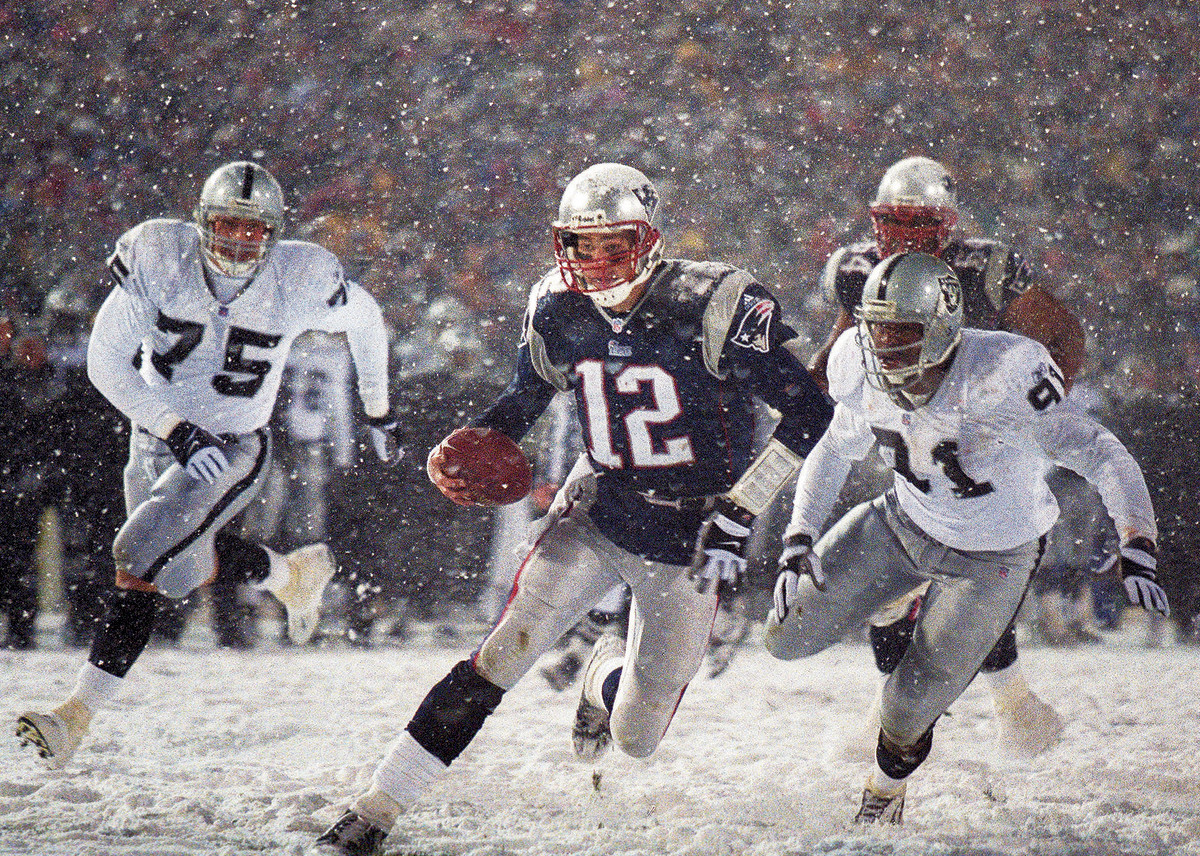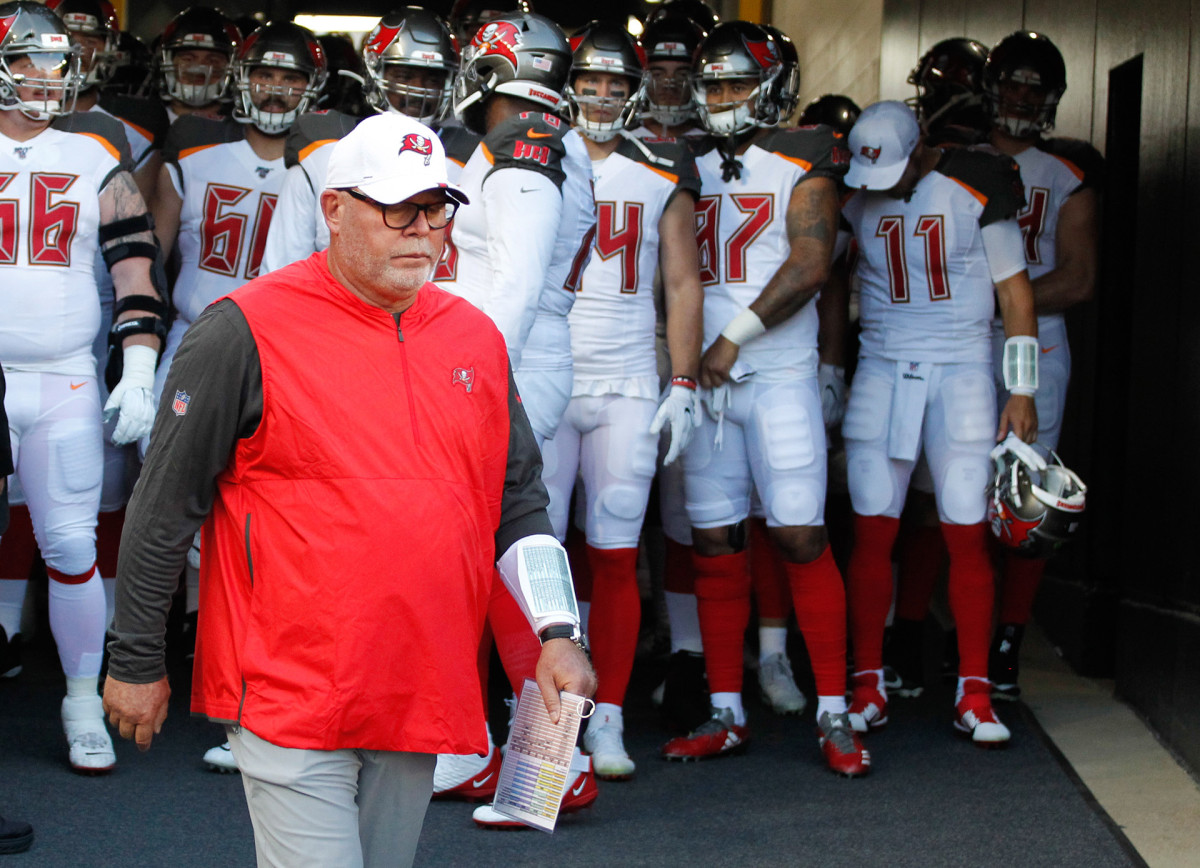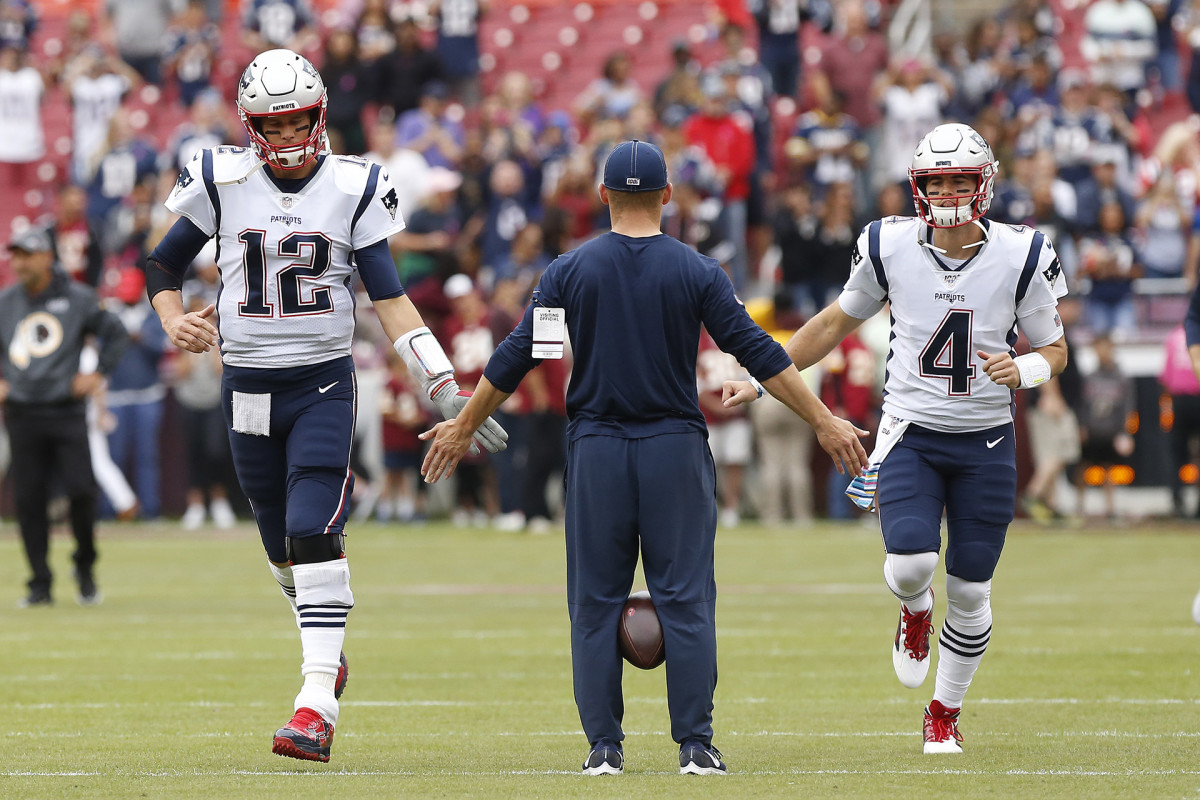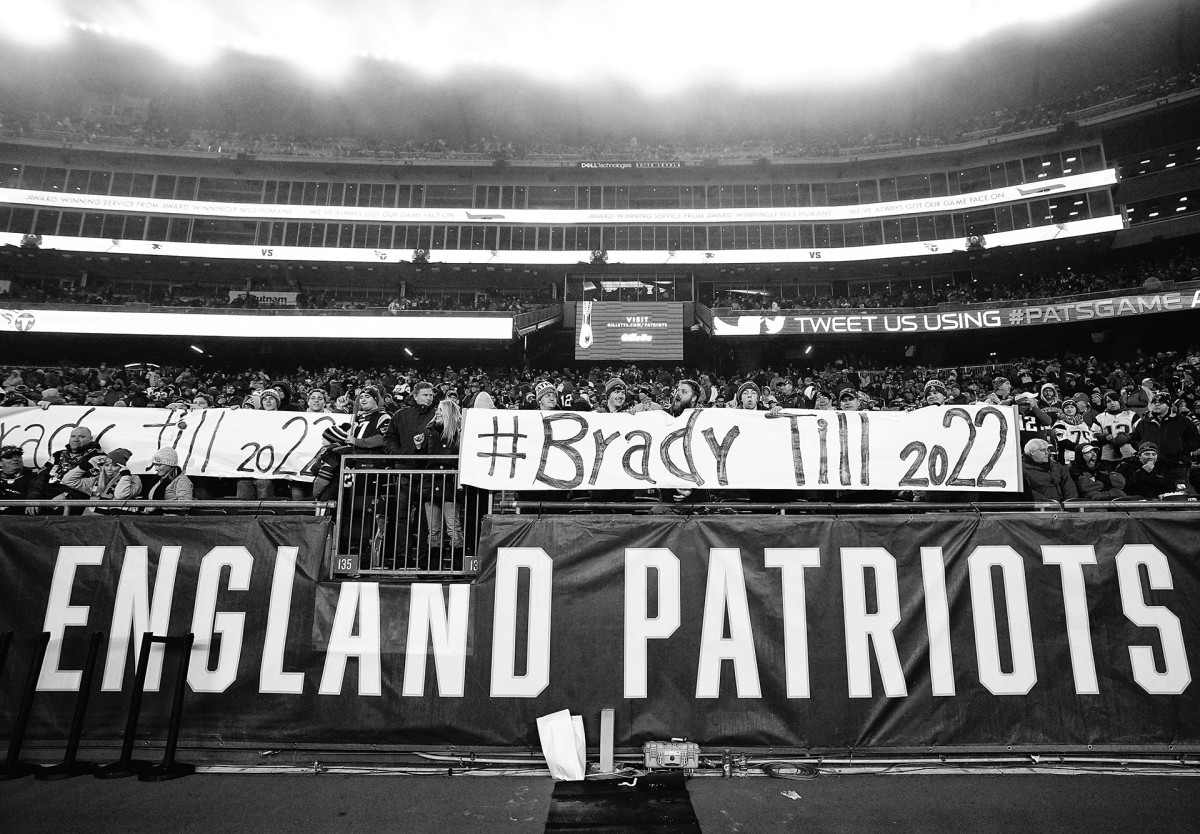Brady Joins the Bucs: Your Guide to the Past, Present and Future of the QB’s Free Agency Saga
WHY—AND HOW—DID IT END IN NEW ENGLAND?
By Albert Breer
The truth is, I don’t know precisely what straw broke the camel's back and ended Tom Brady's two-decade run with the Patriots. But ask me what I think, and I believe it's as simple as this: The greatest to ever play was done playing the Patriots’ games, and that, as I see it, was reflected vividly in his final hours under contract with the team.
As late as Monday morning, there were those in the Patriots building who were still asking why a final meeting between the two of the most important and successful people in league history, Brady and Bill Belichick, couldn’t happen. Why those two couldn’t, one last time, try and put all their cards on the table, and breathe life back into the most successful quarterback/coach pairing in league history. Why they couldn’t see what everyone else could: staying together was best for everyone.
Connect the dots, and it sure seems like one man, Belichick, was doing business as he always had, while the other, Brady, was waiting for something to change. And when it didn’t, Brady wasn’t going back to Belichick to beg for a job he’d so richly earned every single year he’d worn the uniform.

Brady has been fond of saying, “I try to be the best quarterback on this team.” That was a way he stayed connected to his roots—a former sixth-round pick who always felt like he had to earn spot, first and foremost. The Patriots fed into it, too, with Belichick treating him like he would the guy Brady once was, the guy just trying to make the team. And that, plus Brady’s willingness to not clean out the Patriots financially at contract time, enabled a lot of things within Belichick’s program.
Eventually, living that way would wear on anyone. The rings (6), Super Bowl appearances (9), and MVP awards (3) piled up. Brady grew older and had kids, he found business interests outside of football, and he may have been, to some degree, done being dealt with as if he had the leverage of a long snapper. And there was, to be sure, some resulting tension between the coach and quarterback the last few years. If Brady was tired of it? Then, naturally, he’d be a little less patient at the negotiating table.
By the sounds of it, the ballyhooed phone call between Belichick and Brady a few weeks back—whether you want to say it didn’t go well or it was just business as usual—simply confirmed the divide in what each man was looking for. Make no mistake, Brady was willing to return to New England and Belichick was willing to have him, but each was willing to do it only on their own terms. Those sets of terms, evidently, weren’t compatible.
At that point, maybe the Patriots were waiting for Brady to come back and tell them what he was looking for contractually. And maybe some of us—I’ll raise my hand here, because I wasn’t sure he had the stomach to leave—wouldn’t believe what was unfolding. It was already over. Brady wasn’t going back to Belichick hat-in-hand. Belichick, accordingly, wasn’t suddenly going to change how he’d done business for 20 years.
So rather than go to his coach, Brady went to owner Robert Kraft. There was a point when those two would handle these negotiations face-to-face. But Kraft had left this one up to Belichick—an important distinction, given that Kraft has been hands-on with matters affecting the long-term stability of the franchise. But Brady wasn’t going to Kraft to negotiate, he was there to say goodbye.
How things go in Tampa for Brady is anyone’s guess. Bruce Arians won with an aging quarterback in Arizona (Carson Palmer), and there’s a boatload of talent on the Bucs offense. Brady should have some control in working with second-year coordinator Byron Leftwich, and I’m sure there’s some level of excitement in entering into a totally different set of circumstances after two decades in a militaristic program.
Just the same, I’d bet the challenge ahead for the Patriots invigorates Belichick. He’ll get a chance to build differently—maybe with less money tied up in the quarterback position—and add a brand-new layer to his legacy. I don’t think Belichick is that close to the end, because his love for the work has gone nowhere and that passion won’t wane with his quarterback gone. In fact, I wouldn’t be surprised if this gives him something to prove.
As for what we know, that part’s simple too: We’re unlikely to ever see anything like what these two guys accomplished ever again. And we know, after the last couple months emphatically told us so, that this spectacular, unprecedented relationship had finally run its course. If we had taken the time to look, the proof wasn’t hard to find.
* * *

HOW DOES BRADY FIT IN TAMPA’S OFFENSE?
By Andy Benoit
Saddled with a bad receiving corps last season, Brady didn’t play as well as he has in past years, but physically he showed little sign of decline. His arm strength, which has long been underrated, has not diminished much. His precision accuracy was less consistent, but by an insignificant margin. And his mobility didn’t decline because there was nowhere lower for it to go; Brady has always been one of the NFL’s most statuesque QBs. He rarely ventures away from his dropback lane (which is right down the hashmarks) and travels only the minimum amount necessary when he does, almost always staying within the pocket.
Before an aging player’s decline is evident on Sundays, its harbingers become increasingly visible on Tuesdays, Wednesdays and Thursdays. Without knowing the details behind Brady’s and the Patriots’ divorce (was it initiated by the quarterback or by his coach?) we can’t know until fall which Brady the Buccaneers signed. But what we do know is, stylistically, Brady can fit Tampa Bay’s offense.
For months, the speculation was that Brady would join his longtime friend, head coach Mike Vrabel, in Tennessee. But the Titans offense in the second half of last season averaged 36 points per game running a finely tuned outside-zone-based scheme, which is predicated on stretch handoffs and bootlegs. Brady’s immobility badly hinders those designs. In fact, Tennessee would have had to rewrite most of its playbook.
The Bucs do not. Head coach Bruce Arians has one of the NFL’s most north-south-oriented systems. Their ground game is comprised mostly of straightforward inside-zone runs (picture a running back ramming the ball behind double-team blockers). Their pass game, much like New England’s in years where talent surrounded Brady, often gets all five eligible receivers out in routes. Many of those routes are intertwined in ways that out-leverage specific coverages downfield, demanding that a QB aggressively target 18-to 22-yard timing-and-rhythm throws.
Those throws are not necessarily Brady’s forte, but they’re in his wheelhouse and will feel enticing—maybe even liberating—with a lanky 6' 5" target like Mike Evans. The seventh-year receiver also gives Brady the best downfield and jumpball weapon he’s had since Randy Moss.
Another characteristic of an Arians scheme: “tight split” alignments, where a receiver aligns just a few yards away from the offensive tackles, as opposed to all the way out near the sidelines. Those tight splits propagate rubs and picks routes—concepts that Brady mastered in New England. Many of those concepts will feature Chris Godwin, who last season caught 86 balls for 1,333 yards (in 14 games) playing the slot and Z-receiver role. The guy who filled that role for Brady in New England was Julian Edelman.
For years, the only non-quarterback position in New England’s offense that was more important than Edelman’s was tight end, simply because it was Rob Gronkowski. The Bucs don’t have a Gronkowski (no team does), but they have two highly capable receiving tight ends in O.J. Howard and Cameron Brate, both of whom can prosper on crossing routes and down the seams. A one-two tight end punch can be lethal with a smart QB; having that second tight end compels the defense to account for more gaps against the run, limiting what the D can do in coverage. From understanding these limitations, a veteran QB can often decipher that coverage. And in Brady’s case, the QB can audible to a different play that specifically attacks the coverage.
Brady can also check into run plays, which he’s always willing to do against the right look. (Usually, the “right look” involves two safeties aligned deep.) The Bucs’ O-line doesn’t always live up to the road-grading standards that its size suggests, but assuming a replacement is found for free agent right tackle Demar Dotson, it’s a serviceable enough group, and probably even a tick or two better than serviceable in pass protection. That pass protection will now often look sounder than it actually is, thanks to Brady’s quick decision-making and pocket awareness.
This is certainly not the best offense that Brady has been a part of, but given the receiving options, the supporting cast is much better than what he had last season. The first time Brady ever lost a playoff game was 2005 (one year after he won his third Super Bowl). That year is also the last time the Bucs won more than 10 games. Transitioning to Tampa Bay certainly presents an uphill battle for history’s greatest QB, but it’s one Brady is still capable of winning.
* * *

WHO WILL BE THE PATRIOTS’ NEXT QUARTERBACK?
At the 2017 trade deadline, the Patriots traded Brady’s presumptive successor, Jimmy Garoppolo, to the 49ers. Since then, the succession plan in Foxboro has been unclear. What now? With quarterback dominoes falling throughout the league, let’s examine the remaining options for New England.
Jarrett Stidham is the in-house option. The 23-year-old was selected out of Auburn in the fourth round of the 2019 draft. He threw exactly four passes last season as Brady’s back-up last year, three of them in mop-up duty during a Week 3 victory over the Jets, during which Stidham threw a pick-six and was pulled from the game, with Brady returning to the blowout. Brady, of course, was once a little-hyped late-round pick when he took over for Drew Bledsoe, though little is yet known about Stidham’s aptitude for the job. Jim Nagy, the director of the Senior Bowl all-star game, where Stidham performed well last year, wrote on Twitter that Bill Belichick “stole Jarrett Stidham in 4 round. High-end natural arm talent. Comes off his hand so easy.” Nagy added, “Talented enough to be Brady’s long-term successor.”
In position to draft Joe Burrow first overall, the Bengals could either trade or cut Andy Dalton. He’s under contract for one more year for $17.5 million, with no guaranteed money. It wouldn’t be a flashy signing, but since when do the Patriots care about that? He could be a good fit if they are looking for an experienced QB to run their offense as a one-year stopgap or trial.
With the Colts landing Philip Rivers, could the Patriots bring back Jacoby Brissett? Brissett was the Patriots’ third-round pick in 2016, and was traded to Indianapolis before the start of the 2017 season, two months before Garoppolo was dealt. Brissett had an up-and-down season replacing Andrew Luck but would be a known commodity for the Patriots with knowledge of and experience in Josh McDaniels’ system. He played 2½ games as the starter for New England during Brady’s Deflategate suspension, after Garoppolo got hurt.
Shortly after Brady declared his intentions, the Panthers announced they are seeking to trade Cam Newton (they soon after agreed to terms with Teddy Bridgewater). Talent is not the issue for Newton, his health is. Over the last three years, Newton has had two shoulder surgeries and another this past December on the foot injury that ended his 2019 season. There would be a risk in trading for Newton while he is still rehabbing from that latest surgery, but if he can stay healthy, the 30-year-old is an intriguing option.
The Jaguars have said they will let Gardner Minshew and Nick Foles compete for the starting job in 2020. But there has been plenty of speculation that they prefer to move forward with last year's sixth-round pick as their starter. Could the Patriots turn to the Super Bowl LII MVP who outdueled Brady? Foxboro Special, anyone?
The Patriots have the No. 23 pick in this year’s draft, meaning they’d have to make a big jump to get Tua Tagovailoa, Justin Herbert or Jordan Love, the presumed top passers after Burrow. Washington’s Jacob Eason could be available later in the first round. Georgia’s Jake Fromm is short on arm talent but handled an expansive playbook for the Bulldogs and comes from a UGa program Belichick has plucked from often (including 2018 first-round picks Isaiah Wynn and Sony Michel). Another option is Oklahoma’s Jalen Hurts, who many talent evaluators think might go as high as the second round—though New England dealt their second-rounder for Mohamed Sanu at the trade deadline, their second selection is currently 87th overall. Belichick’s history, of course, suggests that they will not go this route: In 25 drafts with the Browns or the Patriots, he has never selected a QB with a top-60 pick. (Garoppolo, taken with pick No. 62, was the highest, which shows how Belichick regarded him). However, he’s also never had to replace Brady.
* * *

WHAT HAVEN’T WE CONSIDERED YET? WHAT ARE THE TRICKLE-DOWN EFFECTS?
By Conor Orr
All the big questions have been addressed, largely. Yet so many remain. Like, what becomes of the TB12 store on the promenade in Foxboro? Does it board up, like some monument to the Belichick-ian philosophy that no one man is bigger than the team? Does it become an urgent-care clinic for Patriots diehards? Or another lonely Edible Arrangements brick-and-mortar? What happens to the gallons of avocado ice cream Brady hooked his teammates and fans on during his raw-food revival? Will anyone stomach it anymore? Does Boston suddenly plunge back into the dangerous world of non-complex carbohydrates and white sugars? What becomes now of all the resistance bands he evangelized, sitting unused in the Patriots’ training room?
What happens to Bon Jovi and Mark Wahlberg? Do they resurface in the owners’ box, Week 1, wearing Jarrett Stidham No. 4 jerseys, pretending the energy hasn’t changed? Do they fly south for the fall and load up on creamsicle Brady gear, paying homage to the player whose 20-year surge buoyed their status as celebrity superfans? Or do they nestle in beside Belichick and assure themselves that, when they appear on the broadcast, they’ll still be celebrating victory after victory?
What happens to CBS and its AFC broadcast package? Brady was an instant return on investment; the star of the most-watched regular season game of the 2019 season and many seasons before that. Even the most middling Patriots game was still a Patriots game. There was a draw. A narrative. Brady was an incentive for even the most distant fan. Now, do Jim Nantz and Tony Romo pivot to Patrick Mahomes, hoisting the young Super Bowl champion atop their mantle? Will we, in turn, accept Mahomes as the new star, Sunday after Sunday, in a drama we’ve been watching for two decades?
What happens in Tampa? Are they ready to be stamped by Brady, Inc.? Are they prepared for Raymond James Stadium to become football Disney World, with a quinoa cake stand next to the beer tent, the seats populated by fairweather fans from nearby investment banks wearing crisp new TOMPA BAY T-shirts? Will it all feel authentic and real enough? Will it be worth the gamble? What happens to Bruce Arians and, perhaps more importantly, his budding star coordinator, Byron Leftwich? Are they prepared for the responsibility of taking a soon-to-be-43-year-old man and turning him into the player everyone remembers?
What happens if Brady, removed from the greatest dynasty in sports, stripped of the familiar armor he’s donned all these years, isn’t really Brady anymore?
* * *

WHAT NOW OF THE BRADY-BOSTON ROMANCE?
When the Patriots’ 2019-2020 season ended after Tom Brady threw a pick-six in the Wild Card game against the Titans, I’m the person who wrote that he couldn’t leave now. That there was no way he’d let his time in Foxboro end like that. That the only logical place for the 42-year-old quarterback was in Massachusetts, where he’d reigned as prince for two decades. All he needed were a few offensive weapons and we—we—would be back in the Super Bowl with Brady, baby. (Narrator: They would not, in fact, be back in the Super Bowl with Brady, baby.) When Brady announced on Tuesday that he will not continue his football career with the Patriots, I typed “Tom Brady Super Bowl LI Celebration” into YouTube, blasted Sarah McLachlan’s “I Will Remember You” and softly wept.
Unless Brady won New England one more ring and promptly mic-dropped, there was never going to be a satisfactory scenario for Patriots fans when it came to his future. Realistically, keeping him would have delayed the inevitable and prevented New England from moving on. But cold hard facts don’t make it hurt any less when you’re left by someone you love, and when I asked Pats fans on Instagram how they were handling the breakup, the prevailing emotions of sadness and gratitude seemed to match mine. “My kids legit cried,” one woman told me. “Devastated,” someone else replied. Another: “We are lost at sea, and I don’t know which direction is which.” Others expressed relief, happiness that the breakup is at least over. “Rip the Band-Aid off.” And, “It was expected. In Bill we trust. Next man up.” (Which man might that be? “Tank for Trevor [Lawrence]!” was a popular response.) A friend from Boston took the long view. “Sad, but no one cares that Joe Montana ended his career with the Chiefs. The Brady retrospective will be just as satisfying when he retires.”
True. If he had to leave, did it really matter where Brady ultimately ended up? It will sting if he gets a seventh ring without the Patriots (in Tampa? whoof), but most fans seem to wish him the best. Because, look, it’s hard to be angry at a man who again and again took a pay cut to stay with the Pats, who delivered six championships to a franchise that had never won one, who’s responsible for millions of dogs in New England being named Brady. Does it sting for Julian Edelman, whose Don’t leave me! campaign culminated last month in his selling T-shirts that read STAY TOM? Definitely. But there he was on Instagram Tuesday, posting a better days picture captioned simply, “Family.” One desperate admirer even left a bouquet of flowers outside Brady’s TB12 storefront in Boston, and a few fans ventured to Gillette to buy Brady’s no. 12. More would’ve made the pilgrimage, but, hey, we’re in the middle of a global pandemic. Was it smart to leave the house? No. But it reminds me of the man who pulled the fire alarm at the Steelers’ hotel on the night before the AFC championship game in 2017 and then told the police, “I’m drunk. I’m stupid. I’m a Pats fan.”
To their credit, Tom and the Patriots made this split as pleasant as possible. Brady didn’t stomp off in rage or make noise about what he was owed. Instead he gushed on Instagram that New England had given him “the happiest two decades I could have envisioned in my life.” Bill Belichick and Robert Kraft didn’t kick Brady out of the house, tossing a cardboard box of TB12 Method books out the window after him. Instead, they released glowing statements. Whatever may have happened behind the scenes, what we saw publicly was the definition of a conscious uncoupling. (Gwenyth Paltrow, the queen of conscious uncoupling herself, commented on Brady’s post and tagged her new husband. Maybe future happiness is possible).
Mom and dad might be divorcing, but they promise to take good care of your memories.
• Question or comment? Email us at talkback@themmqb.com.
